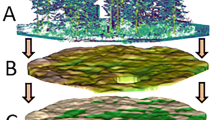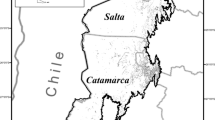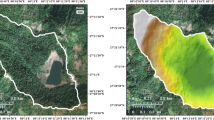Abstract
We present results of research concerning the distribution, depth, volume, geomorphology, and habitat diversity of peatlands in the southern Peruvian Amazon. We identified 295 peatlands covering 294 km2 and ranging in size from 10 to 3,500 ha. Individual peatlands were mostly restricted to the meander belt of the Madre de Dios River. Mean peat depth was 2.54 ± 1.84 m (n = 429), however we encountered depths to 9 m and 10% of the measurements exceeded 5 m. We developed a calibration factor to calculate peat volume across the study area, estimating total peat volume within 295 peatlands at 657 ± 119 Mm3. An interpolated depth map of subsurface morphology of a single peatland showed that fluvial features were well-conserved beneath several meters of peat and three distinct subsurface geomophological units defined by peat depth could be identified: the Primary Basin, Secondary Basin, and Intrabasin flats. Subsurface geomorphology resulted in increased within-habitat heterogeneity and explained 35% of the variation of pixel values extracted from Landsat™ imagery. Representing a hydrological link from elevated uplands to the lower floodplains, peatlands in Madre de Dios are especially threatened on local scales by habitat alteration in the uplands and gold mining in the floodplains.



Similar content being viewed by others
References
Anderson JAR (1975) Palynological study of a Holocene peat and a Miocene coal deposit from NW Borneo. Review of Palaeobotany and Palynology 19:291–351
Andriesse JP (1988) Nature and management of tropical peat soils. FAO Soils Bulletin, vol 59. Food and Agriculture Organization of the United Nations, Rome, Italy
Atrium (2011) Aguajal Project. Andes-Amazon Atrium, accessed November 25, 2011. Link: http://atrium.andesamazon.org/collections_list.php?type=project&id=3&start=0&filters=off
Bailey H (1951) Peat formation in the tropics and subtropics. Proceeding of the Soil Science Society of America 15:283–284
Barberi M, Salgado Labouriau ML, Suguio K (2000) Paleovegetation and paleoclimate of “Vereda de Aguas Emendadas”, central Brazil. Journal of South American Earth Sciences 13:241–254
Batjes NH, Dijkshoom J (1999) Carbon and nitrogen stocks in the soils of the Amazon region. Geoderma 89:273–286
Campbell KE (2001) Upper Cenozoic chronostratigraphy of the southwestern Amazon basin. Geological Society of America 29:595–598
Campbell KE, Frailey CD, Romero-Pittman L (2006) The pan-amazonian Ucayali peneplain, late neogene sedimentation in Amazonia, and the birth of the modern Amazon river system. Palaeogeography, Palaeoclimatology, Palaeoecology 239:166–219
Chason D, Siegel D (1986) Hydraulic conductivity and related properties of peat. Soil Science 142:91–99
Chimner RA, Karberg JM (2008) Long-term carbon accumulation in two tropical mountain peatlands, Andes Mountains, Ecuador. Mires and Peat 3:1–10
Cummings D, Kauffman J, Perry D, Hughes F (2002) Aboveground biomass and structure of rainforests in the southwestern Brazilian Amazon. Forest Ecology and Management 163:293–307
Dubroeucq D, Volkoff B (1998) From oxisols to spodsols and histosols: evolution of the soil mantles in the Rio Negro Basin (Amazonia). Catena 32:245–280
Forsberg B, Forsberg M, Padovani C, Sargentini E, Malm O (1995) High levels of mercury in fish and human hair from the Rio Negro basin (Brazilian Amazon): Natural background or anthropogenic contamination?. In: Kato H, Pfeiffer WC (eds) Proceedings of the International Workshop on Envorinmental Mercury Pollution and its Health Effects in the in the Amazon River Basin. National Institute for Minamata Disease/UFRJ, pp 33–40
Foster RB, Parker T, Gentry A, Emmons LH, Chiccon A, Schulenberg T, Rodriguez L, Lamas G, Ortega H, Icochea J, Wust W, Romo M, Alban Castillo J, Phillips O, Reynel C, Kratter A, Donahue P, Barkley L (1994) The Tambopata-Candamo-Rio Heath Region of Southeastern Peru: a biological assessment. University of Chicago Press, Chicago
Gonzalez Rivadeneyra M (1971) Estudio sobre la densidad de poblaciónes de Aguaje (Mauritia sp.) en Tingo Maria-Peru. Revista Forestal del Peru 5:1–11
Goulding M, Smith N (2007) Palms: Sentinels for Amazon Conservation. Amazon Conservation Association, Washington, 356
Goulding M, Cañas C, Barthem R, Forsberg B, Ortega H (2003) Amazon Headwaters: Rivers, Wildlife, and Conservation in Southeastern Peru. Asociación para la Conservación de la Cuenca Amazónica (ACCA), Lima, Perú
Granville J-J (1974) Apercu sur la structure des pneumatophores de deux especes de sols hydromorphes en Guyane. ORSTROM Ser Biol 23:3–22
Guzmàn Castillo W (2007) Valor económico del manejo sostenible de los ecosistemas de aguaje (Mauritia flexuosa). In: Feyen J, Aguirre L, Moraes M (eds) International Congress on Development, Environment and Natural Resources: Multi-level and multi-scale sustainability, Volumen III. Universidad Mayor San Simon, Cochabamba, pp 1513–1521
Hamilton SK, Kellndorfer J, Lehner B, Tobler M (2007) Remote sensing of floodplain geomorphology as a surrogate for habitat diversity in a tropical river system (Madre de Dios, Peru). Geomorphology 89:23–38
Harris P, Huntingford C, Cox P (2008) Amazon Basin climate under global warming: the role of the sea surface temperature. Philosophical Transactions of the Royal Society Biology 363:1753–1759
Hoekman D (2007) Satellite radar observation of tropical peat swamp forest as a tool for hydrological modeling and environmental protection. Aquatic Conservation: Marine and Freshwater Ecosystems 17:265–275
Houghton R (2005) Aboveground forest biomass and the global carbon balance. Global Change Biology 11(6):945–958
Jardim W, Bisinoti M, Fadini P, da Silva G (2010) Mercury redox chemistry in the Negro River Basin, Amazon: The role of organic matter and solar light. Aquatic Geochemistry 16:267–278
Jauhiainen J, Takahashi H, Hieikkinen J, Martikainen P, Vasander H (2005) Carbon fluxes from a tropical peat swamp forest floor. Global Change Biology 11:1788–1797
Junk W (1983) Ecology of swamps on the middle Amazon. In: Gore A (ed) Mires: Swamp, Bog, Fen and Moor, Regional Studies; Ecosystems of the World 4B. Elsevier, Amsterdam, pp 269–294
Kahn F (1977) Analyse structurale de systèmes racinaires des plantes ligneuses de la forêt tropicale dense humide. Candollea 32(2):321–358
Kahn F (1991a) Los nombres más comunes de palmeras de la Amazonía. Biota 15(97):17–32
Kahn F (1991b) Palms as key swamp forest resources in Amazonia. Forest Ecology and Management 38:133–142
Lähteenoja O, Page SE (2011) High diversity of tropical peatland ecosystem types in the Pastaza- Marañón basin, Peruvian Amazonia. Journal of Geophysical Research, Biogeosciences 116:G02025. doi:10.1029/2010JG001508
Lähteenoja O, Ruokolainen K, Schulman L, Oinonen M (2009) Amazonian peatlands: an ignored C sink and potential source. Global Change Biology 15:2311–2320
Lähteenoja O, Reategui YR, Räsänen M, del Castillo Torres D, Oinonen M, Page SE (2012) The large Amazonian peatland carbon sink in the subsiding Pastaza-Marañón foreland basin, Peru. Glob Change Biol 18:164–178
Ledru M (2001) Late Holocene rainforest disturbance in French Guiana. Review of Palaeobotany and Palynology 115:161–170
Li W, Dickinson R, Fu R, Niu G, Yang Z, Canadell J (2007) Future precipitation changes and their implications for tropical peatlands. Geophysical Research Letters 34:L01403
Oksanen J, Blanchet F, Kindt R, Legendre P, O’Hara R, Simpson G, Solymos P, Stevens H Wagner H (2010) vegan: Community Ecology Package. R package version 1.17–4. http://CRAN.R-project.org/package=vegan
Osher LJ, Buol SW (1998) Relationship of soil properties to parent material and landscape position in eastern Madre de Dios. Geoderma 83:143–166
Page SE, Siegert F, Rieley JO, Boehm H, Jaya A, Limin S (2002) The amount of carbon released from peat and forest fires in Indonesia during 1997. Nature 420:61–65
Page SE, Wust R, Weiss D, Rieley JO, Shotyk OW, Limin S (2004) A record of Late Pleistocene and Holocene carbon accumulation and climate change from an equatorial peat bog (Kalimantan, Indonesia): implications for past, present and future carbon dynamics. Journal of Quaternary Science 19:625–635
Page SE, Rieley JO, Banks C (2011) Global and regional importance of the tropical peatland carbon pool. Global Change Biology 17(2):798–818
Räsänen M, Salo J, Kalliola R (1987) Fluvial perturbance in the western amazon basin: regulation by long term sub-andean tectonics. Science 238:1398–1401
Roulet NT (2000) Peatlands, carbon storage, greenhouse gases, and the Kyoto Protocol: prospects and significance for Canada. Wetlands 20:605–615
Ruokolainen K, Schulman L, Tuomisto H (2001) On Amazonian peatlands. International Mire Conservation Group Newsletter 4:8–10
Schulman L, Ruokolainen K, Tuomisto H (1999) Parameters for global ecosystem models. Nature 399:535–536
Silva-Forsberg M, Forsberg B, Zeidemann V (1999) Mercury contamination in humans linked to river chemistry in the Amazon basin. Ambio 28:519–521
Sebastian A (2002) Globally threatened mammal and bird species in Malayan peat swamp forests. In: Rieley JO, Page SE, Setiadi B (eds) Peatlands for People: Natural Resource Functions and Sustainable Management. Proceedings of the International Symposium on Tropical Peatland, Jarkarta, Indonesia, 22–23 August 2001. BPPT and Indonesian Peat Association (IPA)
Shier CW (1985) Tropical peat resources—an overview. In: Tropical Peat Resources—Prospects and Potential, Proceedings of Symposium held in Kingston, Jamaica 1985, pp. 29–46. International Peat Society, Helsinki, Finland
Suszczynski E (1984) The peat resources of Brazil. In: Proceedings of the 7th International Peat Congress held in Dublin, Ireland, Volume 1, pp. 468–492. International Peat Society, Jyvaskyla, Finland
Watson D (1992) Contouring: a guide to the analysis and display of spatial data. Pergamon Press, London
Wieder R, Canadell J, Limpens J, Moore T, Roulet NT, Schaepman-Strub G (2007) Peatlands and the carbon cycle: from local processes to global implications. EOS 88:295
Acknowledgments
This project was made possible by funding from the Discovery Fund of Fort Worth, Texas, the Gordon and Betty Moore Foundation, the U.S. National Science Foundation (grant no. 0717453), and the Programa de Ciencia y Tecnologia—FINCYT (co-financed by the Banco Internacional de Desarollo, BID) grant number PIBAP-2007–005. We thank Sy Sohmer, Cleve Lancaster, Pat Harrison, Will McClatchey, the board of directors, administration, development, and general staff of the Botanical Research Institute of Texas (BRIT) for providing important institutional support and infrastructure. We are grateful to Keri Barfield, Renan Valega, and Jason Wells of BRIT for logistical support, assistance, and discussion during various phases of this research. We thank Javier Huinga and Angel Balarezo for research assistance in the field. We thank various Peruvian institutions, including the Instituto Nacional de Recursos Naturales (INRENA), the Dirección General de Flora y Fauna Silvestre (DGFFS), the Ministerio de Agricultura (MINAG), and the Ministerio del Ambiente (MINAM) for research, collection, and export permits during the course of this project.
Author information
Authors and Affiliations
Corresponding author
Rights and permissions
About this article
Cite this article
Householder, J.E., Janovec, J.P., Tobler, M.W. et al. Peatlands of the Madre de Dios River of Peru: Distribution, Geomorphology, and Habitat Diversity. Wetlands 32, 359–368 (2012). https://doi.org/10.1007/s13157-012-0271-2
Received:
Accepted:
Published:
Issue Date:
DOI: https://doi.org/10.1007/s13157-012-0271-2




